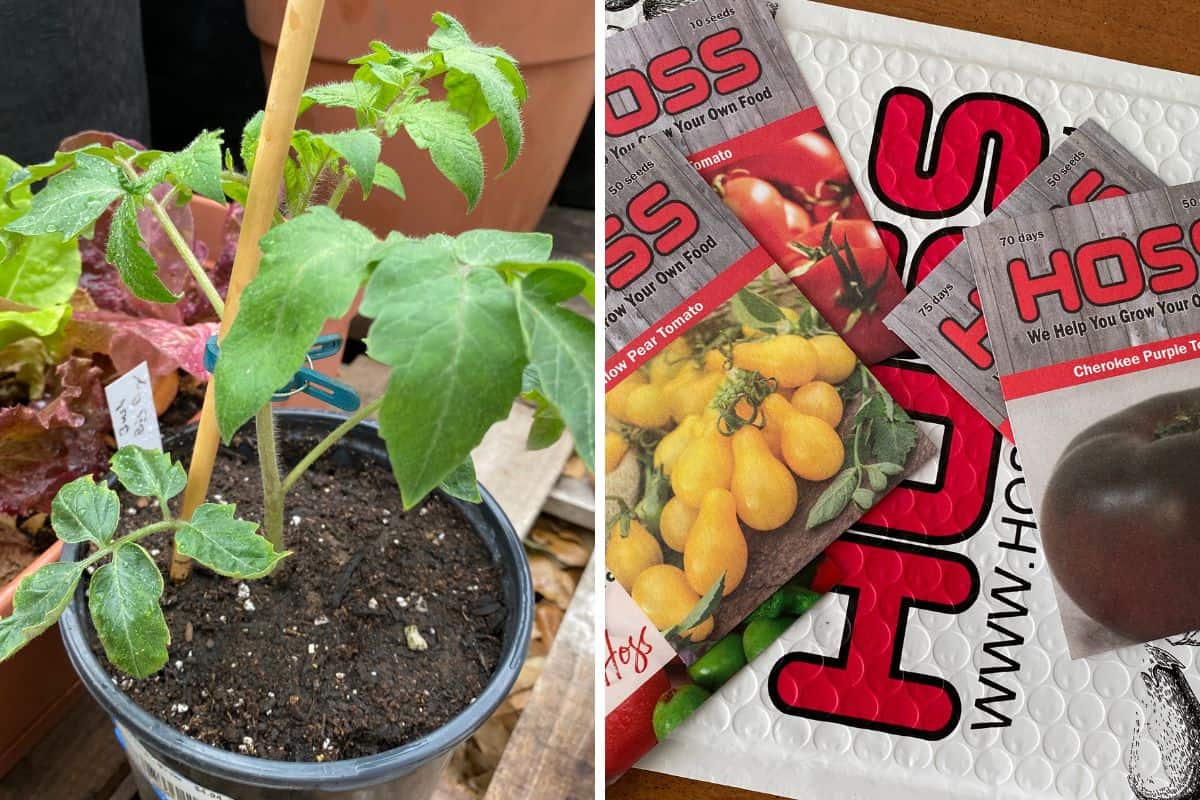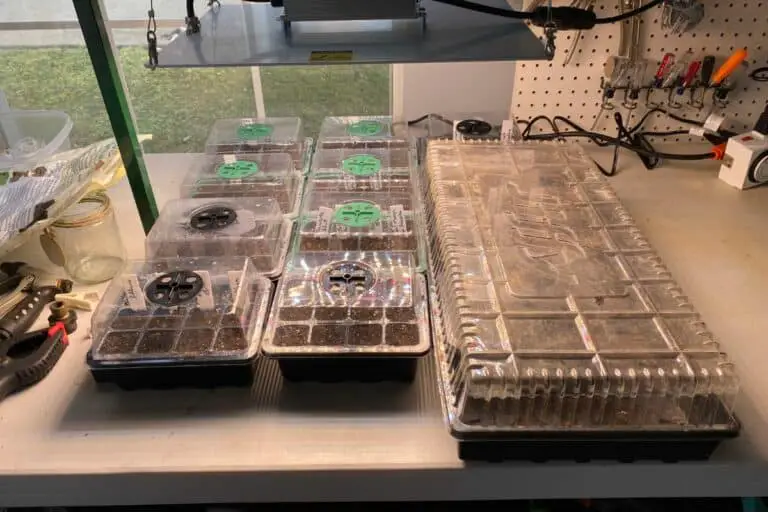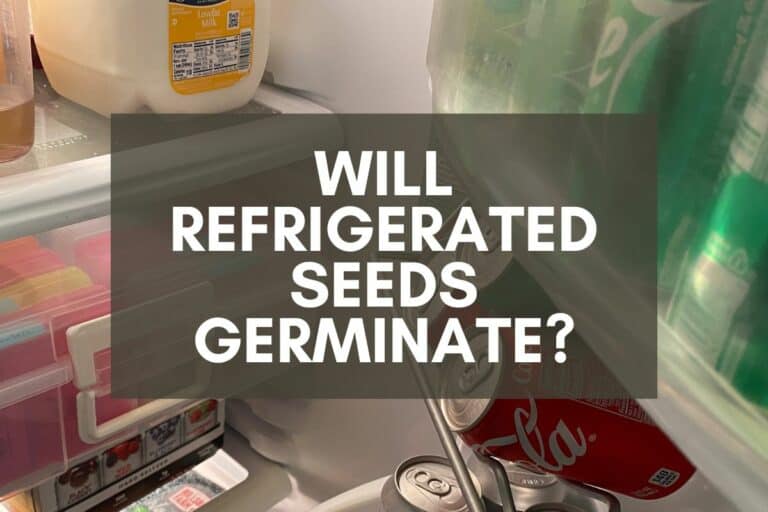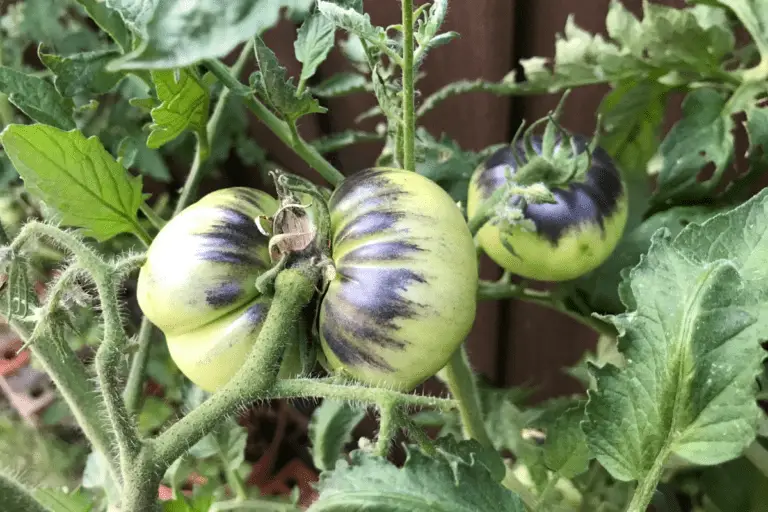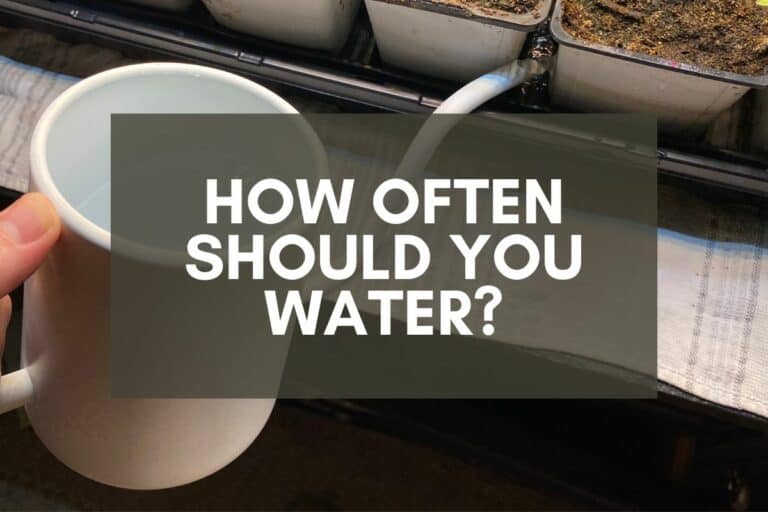Buying Tomato Plants vs. Growing from Seeds: Pros and Cons
If you’re planning to grow tomatoes this year, you might have wondered whether it’s better to buy tomato plants or grow your own.
Maybe you’ve walked into a garden center or your local home improvement store and seen their potted tomato plants. Or maybe you’ve glanced at the websites of various seed supply companies, wondering whether you’d prefer to take a chance with seeds this year.
When it comes to growing tomatoes, most people who are getting into gardening will ask themselves a question at some point along the way: Should I buy tomato plants or grow them from seed?
Beginning gardeners should always start with tomato plants since that’s the easiest way to get a garden going. Experienced gardeners are better off growing plants from seed since it’s both cost-effective to do so and exciting to grow tomato varieties that can’t be found in grocery stores.
I gardened for several years before I took the plunge and started growing tomatoes from seed. Once I had the right setup in place, it was much easier than I had initially anticipated because I was already well-acquainted with the ins and outs of growing tomatoes from store-bought plants.
Since I’ve both purchased tomato plants and grown tomatoes from seed over the past 10+ years, I thought I’d shed some light on the pros and cons of each approach to help you determine which one will best suit your needs.
One quick thing: If you’re planning to grow tomatoes from store-bought plants, you don’t need to pick up any additional equipment. Simply purchase the plants at your local garden center or home improvement store and put them in the ground or in a 5-gallon or larger container, then water and fertilize them as often as needed.
Is It Better to Buy Tomato Seedlings or Seeds? Expert Tips
Once you’ve decided to put tomato plants in your garden, you’ve got to consider whether you’ll be better off purchasing store-bought plants or growing your plants from seed.
Here’s the thing: There’s no right answer to this question. What you choose to do entirely depends on your priorities and interests.
When I first started growing tomatoes back in 2009, I had no idea what I was doing. I drove to Lowe’s one day, bought several 5-gallon buckets and bags of soil, and picked out several different tomato plants.
Over the next few months, I loved watching the plants grow, but I also realized very quickly that I needed to learn how to ward off eager birds and nasty garden pests like aphids, snails and slugs, spider mites, and stink bugs, to name a few.
(If you’d like to see a photo of my first container garden, check out my bio page.)
Long story short, store-bought plants were definitely the way to go when I was a novice gardener because I needed to learn gardening basics. But as time went on, I wanted more variety. I also wanted to spend less on plants each year, so I decided to buy the necessary equipment and start growing my own.
What I’m going to do in this article is walk you through all of the pros and cons that I’ve experienced after years of both buying plants and growing them from seed. There’s lots to consider, but once you’ve read this article, you’ll know everything you need to do to make the choice that works best for you.
Buying Tomato Plants: Pros and Cons
Let’s start with buying store-bought tomato plants since that’s my recommended method for anyone who’s relatively new to gardening.
Here’s an overview of my general recommendations. Keep reading below to learn more about each characteristic.
| Buying Tomato Plants | Pros | Cons |
|---|---|---|
| Convenience | ✔ | |
| Planting Ease | ✔ | |
| Plant Maturity | ✔ | |
| Cost | ✔ | |
| Plant Size and Shape | ✔ | |
| Plant Health | ✔ | |
| Pests | ✔ | |
| Selection | ✔ |
Pro: Convenience
What’s nice about store-bought plants is how convenient they are. Simply drive to your local garden center or home improvement store and pick out the tomato varieties you want. All that’s required is some money, a little time, and a nice afternoon of planting.
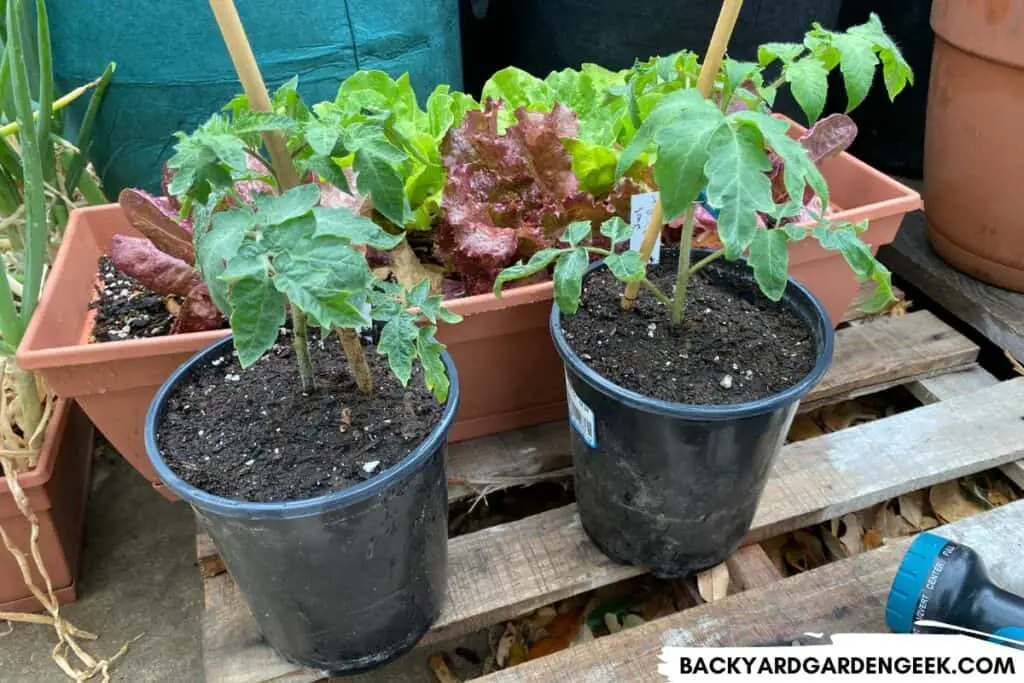
Pro: Planting Ease
Because you’re purchasing plants that are anywhere from 4-6 weeks old, planting them becomes easy since you don’t have to worry about pill bugs or other critters decimating your seedlings. Simply pick the spot you wish to plant in and put the plant there. It doesn’t get any easier than that!
Pro: Plant Maturity
Buying more mature plants for your garden can mean getting a jump on the growing season, especially if you purchase the plants and get them in the ground right after the final spring freeze in your region.
Most tomato plants will begin producing fruit in 60-90 days, so if you purchase a plant that’s 4-6 weeks old and plant it the first chance you get after the last freeze has passed, you’ll be harvesting tomatoes in only 4-8 weeks depending on the variety.
Now that I’ve covered the pros of buying tomato plants, let’s look at the cons of store-bought plants:
Con: Cost
This is the most obvious con since you’ll notice it immediately when you pick up and purchase your plants. Depending on the size, tomato plants typically cost anywhere from $1.99 to $7.99 per plant.
You’ll save some money if you buy a 6-pack of smaller-sized tomato plants, but you’ll still be paying much more for plants than you would if you were growing your plants from seed.
Con: Plant Size and Shape
When you buy tomato plants from the store, you get what you get.
What I mean is this: You have no control over how the plant was grown, so some plants will have a weak main stem, others will look scraggly, and quite a few will have multiple stems because the nursery’s employees didn’t separate the tomato seedlings.
Once you put your plant in the ground, you can trim it as needed so that it grows the way you want it to grow, but this is something to keep in mind if you’re shopping for plants at the store.
Con: Plant Health
Compared to plant size and shape, plant health is much, much more important. Here’s why: If you buy a tomato plant that’s already picked up a disease, chances are your plant will struggle to produce the tomatoes you’re looking for.

In fact, certain diseases can stunt plant growth or kill tomato plants altogether, so when it comes time to purchase a tomato plant, pay very close attention to the leaves. If you notice brown, rusty-looking spots or a yellowing of the leaves, it’s best to pass up those plants for others that look healthier.
Con: Pests
One of the biggest cons that comes with buying plants from the store is the possibility of introducing new pests to your property.
Store-bought plants are grown in large nurseries, then transported to local garden centers and home improvement stores, sitting outside for days at a time waiting for buyers to purchase them.
Between their exposure to fluctuating temperatures and their transportation between numerous locations, plants can easily get a bit stressed and pick up nasty garden pests along the way. Aphids, caterpillars, snails and slugs, spider mites, stink bugs, and whiteflies: These are just a few of the pests that plants can inadvertently pick up on their way from nurseries to retailers.
I recommend quarantining any store-bought plants for a few days before planting them in your garden. That way, you’ll be able to tell if the plant has any pests on it, and if so, you’ll have time to identify and stop those pests from spreading to the rest of your garden.
Con: Selection
If you’ve ever purchased plants at the local garden store, you’ve likely had to choose between 5-10 popular varieties. Unfortunately, those varieties might not be the best for your region, and the tomatoes they produce might not be the most flavorful either.
This is definitely a con compared to the thousands of tomato varieties you can buy from reputable online seed suppliers.
Growing Tomatoes from Seeds: Pros and Cons
Now that we’ve covered store-bought tomato plants, let’s take a look at the pros and cons of growing your tomato plants from seed.
Here’s a quick overview. You can find detailed descriptions of each characteristic below:
| Growing Tomatoes from Seeds | Pros | Cons |
|---|---|---|
| Cost | ✔ | |
| Plant Size and Shape | ✔ | |
| Plant Health | ✔ | |
| Pests | ✔ | |
| Selection | ✔ | |
| Convenience | ✔ | |
| Time | ✔ | |
| Seasonality | ✔ |
Pro: Cost
There’ll always be some initial startup costs associated with growing plants from seed, but once you’ve purchased the right equipment, growing plants from seed is much more cost-effective than purchasing them at the store.
Most seed companies sell tomato packets for $2-$5, and each packet usually contains 20-25 seeds. If I purchased 25 plants at the store for $1.99 per plant, I’d spend over $50 on plants. If I grow that same number from seed, I might only spend $2.50 or so.
As you can see, the savings will really add up if you’re willing to grow your plants from seed.
Pro: Plant Size and Shape
Unlike plants grown by nurseries and sold at garden centers, when you grow your own plants from seed, you can nurture and prune them in whatever way you want.
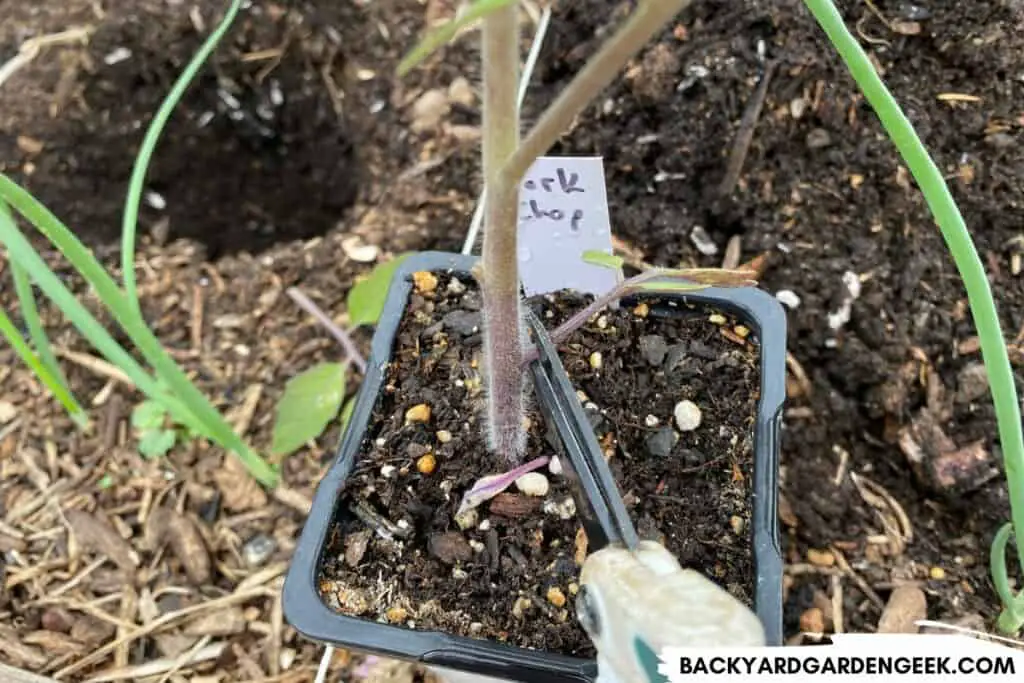
Personally, I like to single-stem my plants (i.e. cut off all of the sucker branches) until they’re at least a few feet tall so that the plant develops a strong main stem. But if you’re growing your own from seed, you have the freedom to do whatever you want to do.
Pro: Plant Health
One of the biggest benefits to growing your own plants from seed is working to ensure that the plants are as disease-free as possible.
Tomato seeds don’t need sunlight to germinate, but once the sprouts break the surface, I lower my grow lights to 1-2 inches (2-5 cm) above the plants, giving them all the light they need to develop into strong, healthy seedlings.
Once the plants go in the ground, I mulch heavily around each of them, watering closely around the base to cut down on splatter, cutting off all branches that hang anywhere near the ground, and pruning overlapping branches that can trap moisture and encourage fungal growth.
Pro: Pests
What’s nice about growing plants from seed is watching them germinate and grow and making sure they’re free of garden pests.
In fact, in all the years I’ve gardened, garden pests have rarely caused any problems for me during the seed-starting and seedling-growing stages. I grow most of my plants in the garage and thus keep them protected from roving insects. I also take a look at them most days, so I can easily tell if something’s amiss and needs to be remedied.
On a handful of occasions, I’ve decided to use neem oil on some seedlings since I knew aphids were lurking around my plants, but most years, I don’t really have to worry about bugs until I put the plants in my garden. Aphids, spider mites, and other pests are bound to show up, but at least my homegrown plants have a chance to get well-established root systems before the pests arrive.
Pro: Selection
Here’s where growing plants from seed definitely bests buying them at the store. If you’ve never browsed the tomato varieties available for sale at Baker Creek, Botanical Interests, or Wild Boar Farms, I highly recommend doing so! As you’ll see after a few cursory searches, there are literally thousands of tomato varieties that you’ll never eat in your life unless you grow them from seed.
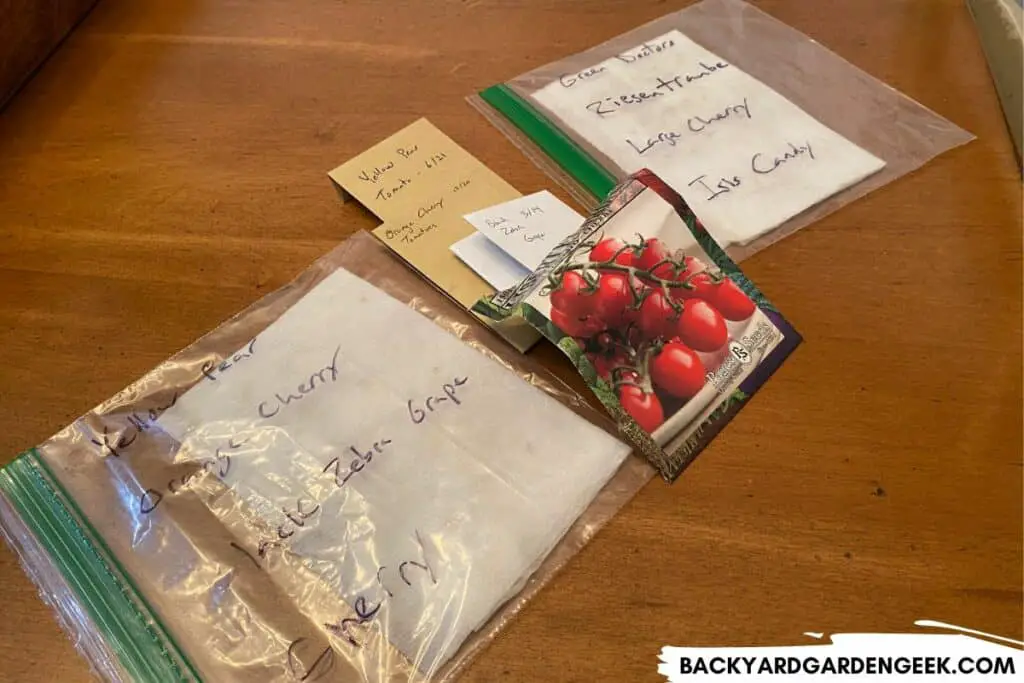
In fact, I grew several tomato varieties this year that I’d never tried before: Barred Boars, Paul Robesons, and Pork Chops, to name a few. I enjoyed all 3 of them, but the Paul Robesons blew me away. They were some of the best tomatoes I’ve ever had!
And guess what: The only people in my neighborhood–or even possibly in my entire city–to have had Paul Robeson tomatoes this year were probably me, my wife and kids, and the family members, friends, and neighbors whom I gave some to. You can’t buy these tomatoes anywhere, so unless someone else was growing them in their backyard, I’m one of the only people within miles who got to try them this year.
Long story short, once you start growing your own tomatoes–and when you realize just how amazing some of these heirloom and specialty varieties can be–you’ll never look back.
As you can obviously tell, I’m a big fan of growing tomato plants from seed, but there are certain drawbacks to the process:
Con: Convenience
If you purchase tomato plants at the store, you can drive there, buy your plants, drive home, and plant everything in just a few hours.
The same can’t be said for growing tomato plants from seed. You’ll need to plan in advance, then devote the time and care necessary to germinate tomato plants and nurture their growth. In other words, there are lots of things to consider when growing plants from seed, much more than if you simply head to the store and buy what you want.
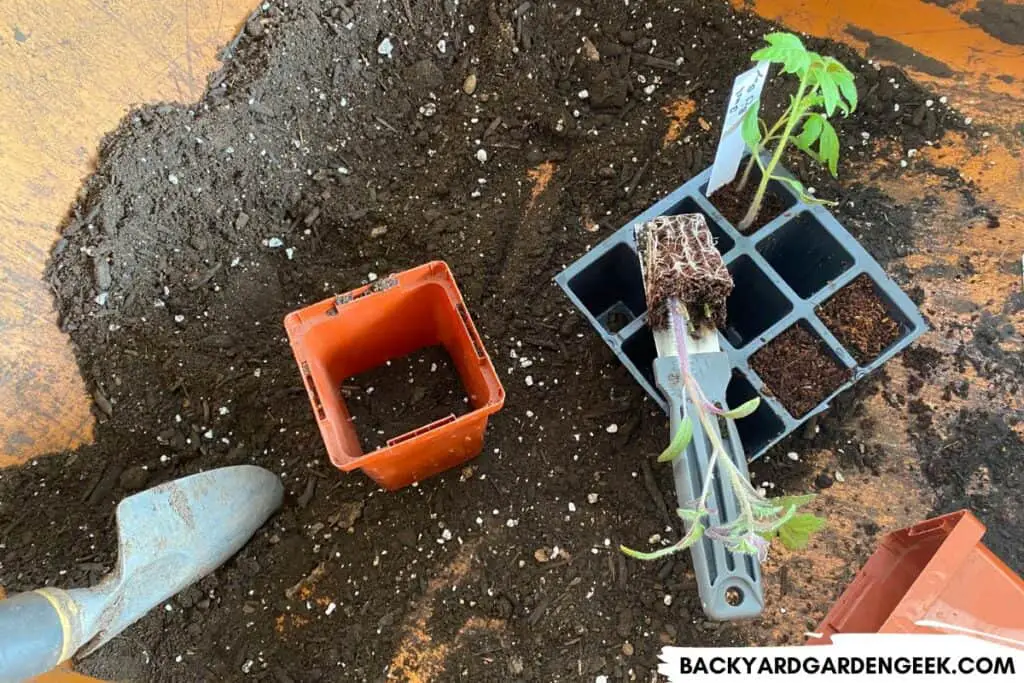
Con: Time
Not only is it more inconvenient to grow plants from seed, it’s also much more time intensive. You’ve got to purchase seeds, prepare the seed-starting mix, plant the seeds, keep the soil moist, keep the grow lights positioned properly above the soil, transfer your seedlings into larger pots, and monitor everything daily once the plants germinate and begin growing.
Over the years, I’ve experimented with germinating seeds in water, planting seeds from fresh tomatoes, and collecting seeds from hybrid varieties. I love to play around and try new things, but here’s the rub: All of this takes time.
Personally, I think it’s fun, but if you’re strapped for time, growing tomato plants from seed might be something you’re better off avoiding until you’ve got more time on your hands.
Con: Seasonality
Growing plants from seed isn’t just a time-intensive activity. It’s also one that relies on proper timing, given the seasonality of gardening.
If you start your seeds too early, they’ll grow far too large before you’re able to plant them outside. If you grow them too late, you’ll miss out on some of the best weather of the spring, which means your plants won’t produce as many tomatoes as they might have otherwise.
The key with growing tomato plants from seed is to pay close attention to timing so that you start your seeds roughly 5-6 weeks before the final spring frost in your region. Those who live in hotter growing zones can get a fall harvest from their plants, but you’ll need to time things correctly; otherwise, your plants won’t produce all that much before the first fall frost hits.
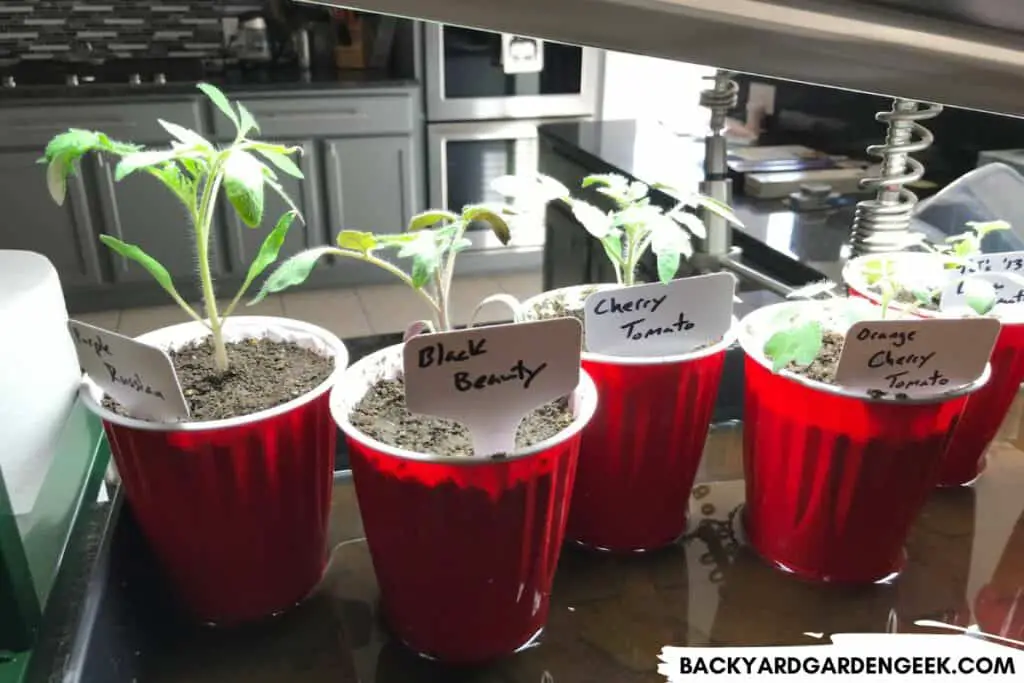
Long story short, what I’ve tried to demonstrate in this article is that neither approach is better than the other since there are pros and cons to both purchasing plants from the store and growing your own from seed.
But now that you know what those pros and cons are, I’m hoping you’ll be able to make the most informed decision possible when it comes time to do so.
When Should I Buy Tomato Plants?
If you’re interested in purchasing store-bought tomato plants, you’ll want to make sure you buy them at the appropriate time of year for your region.
As I suggested above, buy them too early, and you’ll have to keep them indoors while you wait for the weather to warm up and the final frost to pass. Buy them too late, and you’ll miss out on some of the most important weeks of the spring growing season, which will result in lower overall fruit production.
Store-bought tomato plants should be purchased soon after the final spring frost so that they can be planted outside immediately. If purchased later in the season, tomato plants will grow until they’re stalled by hot summer temperatures or killed off by the first fall frost.
When it comes to purchasing plants, you want to get them in the ground as soon as possible. If you’ve got coverings to protect them from frost, you can even do so before the final frost in your area, but for convenience sake, I recommend waiting until you think the last frost has passed, then going to the store and buying whatever plants you’re interested in putting in your garden.
One word of warning: There are sometimes unexpectedly late frosts that occur, so I think it’s best to have some frost cloth on hand in case a late frost comes out of nowhere to threaten your newly planted tomatoes.
Are Plants Grown from Seed Stronger?
My community garden friends and I like to joke that our “volunteers” (i.e. the plants that popped up unexpectedly in our garden beds) grow better than the ones we’ve bought or grown ourselves, but this brings up a good question: Are plants stronger when you grow them from seed?
Plants grown from seed are no different than store-bought plants. However, they’re not subjected to the same environmental stressors–such as sun scald, uneven watering, infestations, and disease–so they’ll often develop stronger root systems earlier, allowing them to outproduce store-bought plants.
As I suggested above, one of the pros of growing your own plants from seed is that you can monitor the growth and care for the plants in ways that employees at large box stores and nurseries never will.
This is why you’ll need to pay close attention to the plants you purchase from local retailers. At first glance, the plant might look just fine, but if you take a closer look, you might notice all kinds of issues that you wouldn’t have seen otherwise.
More Information
If you’d like to learn more about growing tomatoes from seed, check out these related articles:
